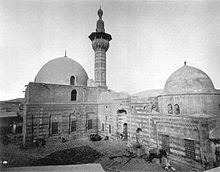Affiliation Islam Completed 1568 Materials Stone, marble, tile Architectural style Ottoman architecture Region Levant Architectural type Mosque | Status Active Dome(s) 1 Opened 1568 Material Marble Number of minarets 1 | |
 | ||
Location Al-Midan, Damascus, Syria Similar Sinan Pasha Mosque, Darwish Pasha Mosque, Al‑Muhafaza Stadium, Hanabila Mosque, Yalbugha Mosque | ||
The Murad Pasha Mosque (Arabic: جامع مراد باشا, transliteration: Jami Murad Pasha) is an early Ottoman-era mosque and mausoleum in Damascus, Syria, located in the Suwayqa sector of the Al-Midan quarter. The mosque was erected and named after Murad Pasha, who served as the Ottoman governor ("wali") of Damascus between 1568-1569. The mosque was built in 1568. The mosque is also known as the Naqshbandi Mosque (Arabic: جامع النقشبندي) after the Naqshbandi sufi order which it served as a center for.
Architecture
The mosque is built in the style of Ottoman mosques, rather than the prevalent styles in Arab lands. The building is noted for its similarities with other Ottoman-era mosques in Damascus, including Tekkiye Mosque and the later Darwish Pasha Mosque. The walls of the mosque were built using alternating lines of black and white stones. The mosque is built around a large courtyard ("sahn"), which features an elaborate fountain that was used for ablution ("wudu"). The courtyard is surrounded by an arcade of domed cells ("riwaq"), which were used as sleeping rooms by students and scholars at the mosque. The structure's walls are decorated with elaborate qashani tile panels. The interior rectangular prayer hall is roofed by a typical Ottoman-style lead-covered dome. The prominent hexagonal-shaped minaret is singled out as the only element built in "the image of the minarets of the Arab lands." The mosque also holds in one of its corners the mausoleum where Murad Pasha was buried. The mosque's main gate holds kufic inscriptions that mention the mosque's construction date and its patron's name.
